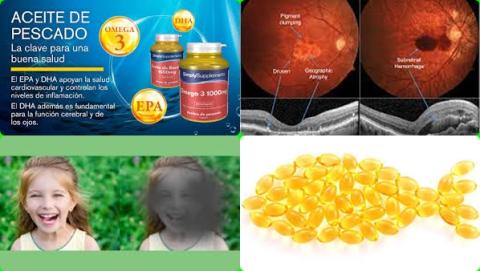
Objectives:
Previous population studies on the associations between dietary fatty acids (FAs), plasma FAs levels and the risk of age-related macular degeneration (AMD) have yielded inconclusive results. Therefore, this review article (meta-analysis) has been conducted.
Do higher dietary fatty acids (EPA and DHA) intakes or higher plasma fatty acids levels reduce risk of age-related macular degeneration?
Study design:
This review article included 11 prospective cohort studies with 167,581 participants. During the follow-up periods (ranging from 3 to 28 years), 6,318 cases of age-related macular degeneration were recorded.
Results and conclusions:
The investigators found that each 1 g/day increment of dietary intake of docosahexaenoic acid (DHA) and eicosatetraenoic acid (EPA) combined significantly reduced risk of early age-related macular degeneration with 33% [RR = 0.67, 95% CI = 0.51 to 0.88].
Significantly means that there is an association with a 95% confidence.
The investigators found that each 1 g/day increment of dietary intake of docosahexaenoic acid (DHA) significantly reduced risk of early age-related macular degeneration with 50% [RR = 0.50, 95% CI = 0.32 to 0.78].
Significantly means it can be said with a 95% confidence that each 1 g/day increment of dietary intake of docosahexaenoic acid (DHA) really reduces risk of early age-related macular degeneration with 50%.
The investigators found that each 1 g/day increment of dietary intake of eicosatetraenoic acid (EPA) significantly reduced risk of early age-related macular degeneration with 60% [RR = 0.40, 95% CI = 0.18 to 0.87].
Significantly because RR of 1 was not found in the 95% CI of 0.18 to 0.87. RR of 1 means no risk/association.
The investigators found that higher plasma docosahexaenoic acid (DHA) levels significantly reduced risk of advanced age-related macular degeneration with 28% [RR = 0.72, 95% CI = 0.55 to 0.95].
The investigators found that higher plasma eicosatetraenoic acid (EPA) levels significantly reduced risk of advanced age-related macular degeneration with 43% [RR = 0.57, 95% CI = 0.40 to 0.81].
The investigators concluded that 1 g/day of dietary intake DHA and 1 g/day of dietary intake EPA and higher plasma DHA and EPA levels are associated with a reduced risk of age-related macular degeneration.
Original title:
Dietary fatty acid intake, plasma fatty acid levels, and the risk of age-related macular degeneration (AMD): a dose-response meta-analysis of prospective cohort studies by Zhong Y, Wang K, [...], Yao K.
Link:
https://pubmed.ncbi.nlm.nih.gov/33469697/
Additional information of El Mondo:
Find more information/studies on EPA en DHA and elderly right here.
A high plasma EPA and DHA content can be obtained by eating a lot of oily fish and/or by taking EPA and DHA supplements (fish oil supplements).
Oily fish contains more EPA and DHA than non-oily fish.
Early age-related macular degeneration: most people do not experience adverse symptoms or vision loss in the early stage of age-related macular degeneration, but night vision problems are often reported. Though no pigmentary abnormalities are apparent upon examination, medium-sized drusen (>63 μm and ≤125 μm) are present.